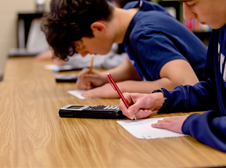Dealing with Stress and Anxiety (for you and your kids)
Amber Brandt
Amber Brandt
Articles by Amber
-
Five Important Conversations to Kick Off a New School Year
Published: Jun 25, 2024
-
4 Ways to Combat the Summer (Learning) Slide
Published: Jun 11, 2024
-
First Day of School: Tips for a Smooth Start
Published: May 09, 2024
-
Healthy and Warm Food Ideas for Cold Days
Published: Mar 19, 2024
Even from a very young age, children can experience anxiety and stress. Babies and children experience separation anxiety from their parents often before they can even speak in full sentences. It’s a very normal human emotion to feel concerned and afraid of what we don’t know.
With an increase in academic pressure, world news, social media and the FOMO (Fear of Missing Out) it creates, your child may be experiencing more pressure and anxiety than ever. But how can you know for sure? Here are the signs experts say you should be looking for (across a spectrum of ages) and how to help:
- Mood swings
- Acting out
- Changes in sleep patterns, including insomnia or nightmares
- Bedwetting or picking up new habits like thumb sucking, hair twirling, etc.
- Physical effects (stomach aches or headaches)
- Difficulty concentrating or completing schoolwork, or changes in academic performance
- Social changes (withdrawing or spending more time alone)
When looking to help reduce stress for your child, experts recommend proper rest and good nutrition as the first two items to check off the list. Just like adults, children are much better equipped to cope with upsetting circumstances when they’re well rested and fed.
The next step is to simply make yourself available – whether they want to talk or not. Quality time goes a long way, and it may even help your child open up about what’s bothering them (if they’re old enough to find the words). Sometimes just knowing you are near could be enough to calm their nerves.
When your child seems like they may be ready to share, ask them if they want to discuss what’s happening. Together you could discuss solutions (talking with teachers, keeping a journal, incorporating exercise, or eliminating unnecessary activities to simplify their weekly load) and see what seems helpful. It’s good to let your child take the lead here with direction from you (they often know what may help). It’s important your child understands their feelings are normal and okay, and that you’re here to help. Anything you can do to instill confidence and trust will help them begin to sort things through. There are also loads of resources online that can help your child practice breathing and mindfulness if they need tools to help them calm down and relax.
Some situations may require additional help, in which a therapist or counselor is your greatest resource. Please feel free to reach out to us for recommended resources if you think your child may need some professional guidance.
And what about you? Are you feeling anxious about everything happening in our world? Here are a few tips adults can use to feel less anxious or worried.
Shift your focus. When the future feels uncertain, it’s easy to worry about it. But anxiety multiplies in the unknown. We worry because we’re afraid of what’s next, and we can quickly find ourselves spiraling down into worst case scenarios. That’s why the first step to combating anxiety and stress is simply to accept that life may be different for a while. Try to focus on what you can control.
Know when to turn off the news. Our 24-hour news cycle never quits. If you’re having trouble avoiding the latest reports, set an alarm on your phone and only check the latest news a 2-3 times a day. Limit your interaction with news websites or your Facebook feed.
It’s okay to slow down, but don’t cut off. It’s easy to get caught up in our own little world and not let others know when we’re hurting, struggling, or lonely. Anxiety has a way of making us feel like a liability to the ones we love, but you have people in your life who love you and want to know what’s going on. Just like you would for your child, if you’re dealing with anxiety or concerns that feel beyond your control, it’s okay to seek help. Talk to someone trustworthy and professional who can help you get clarity and find peace.

